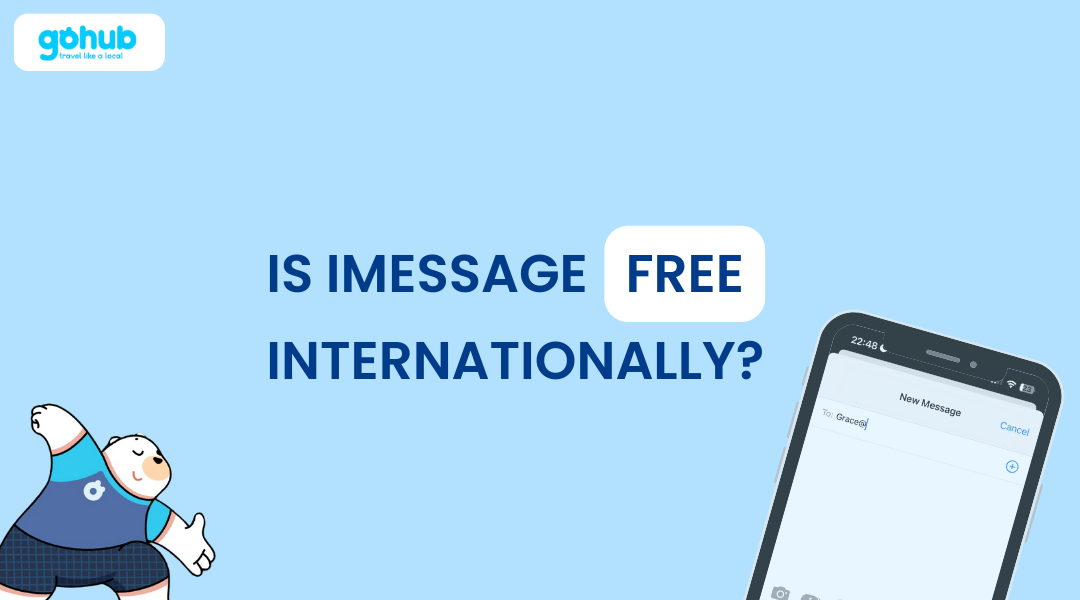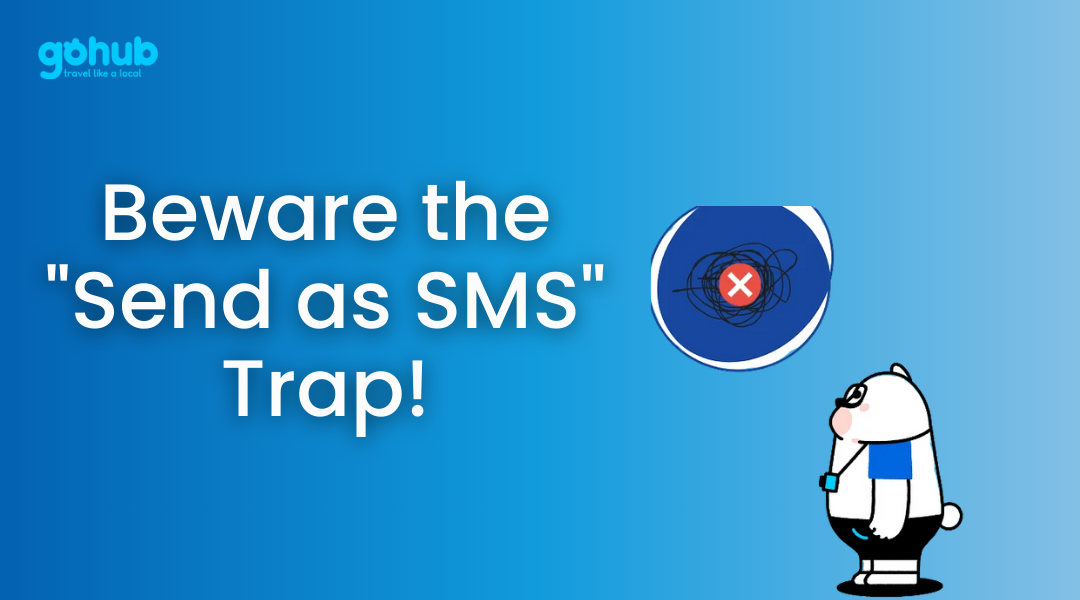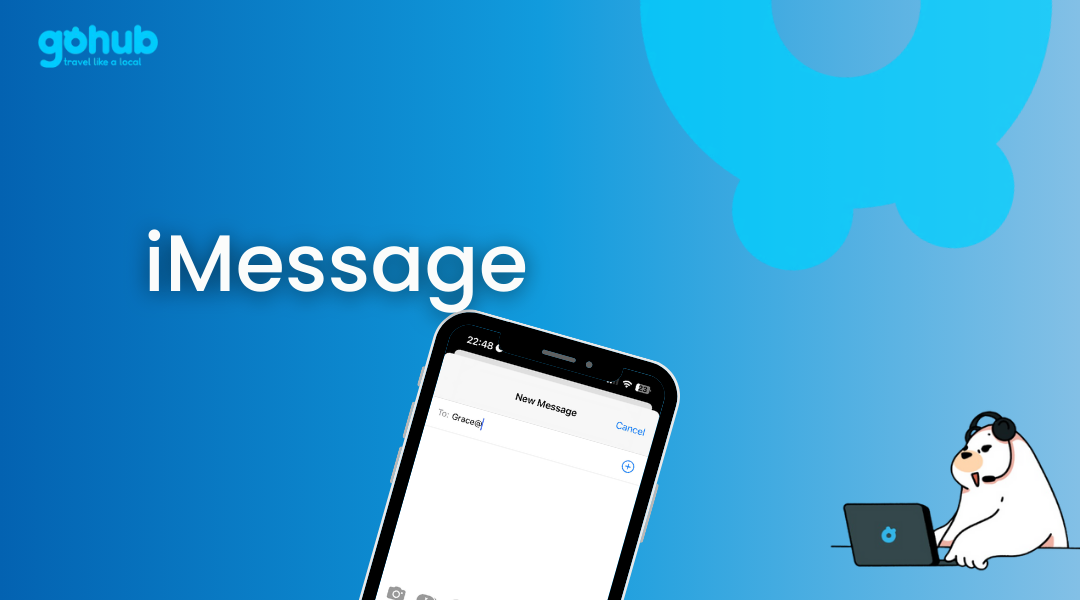Getting ready for a big trip abroad? ✈️ Whether you’re on a work assignment, studying overseas, or just exploring the world, staying connected with family and friends matters — and you shouldn’t have to worry about huge messaging bills.
If you’re an Apple user, you’ve probably wondered: Is iMessage free internationally?
👉 Short answer: Yes — mostly! But to really use iMessage internationally without surprise charges, you need to know a few important tips.
In this easy-to-follow guide, we’ll cover:
- How iMessage works differently from normal SMS
- When it’s 100% free — and when you might accidentally pay
- How to set up iMessage before your trip
- How affordable eSIMs can help you save money while traveling
Whether you’re texting from a coffee shop in Paris or video-calling family from a beach in Bali, here’s how to stay connected safely and affordably using iMessage abroad.

I. Understanding the Basics: iMessage vs. SMS
Before we dive into costs, let’s quickly clear up the difference between iMessage and traditional SMS/MMS.

What is SMS/MMS?
- SMS (Short Message Service): Regular text messages sent over your mobile carrier’s network.
- MMS (Multimedia Messaging Service): Messages that include pictures, videos, or other media.
- Important: SMS/MMS are tied to your phone number and can incur international charges when sent abroad.
What is iMessage?
- iMessage is Apple’s messaging service, used only between iPhones, iPads, and Macs.
- Sent over the Internet: It uses Wi-Fi or cellular data, not your mobile network.
- Linked to your Apple ID or phone number: You can send/receive messages even if your phone number changes.
- Easy way to tell:
- Green bubbles = SMS (may cost extra)
- Blue bubbles = iMessage (free over the Internet)
🎯 In short: If your messages are showing up in blue bubbles, you’re using iMessage — no worries about international SMS fees if you’re connected to Wi-Fi!
II. The Cost Factor: Is iMessage Free Internationally?
When it comes to using iMessage abroad, the answer is: mostly free — but it depends on your connection.
Here’s the full breakdown you need to stay worry-free:
iMessage Over Wi-Fi: 100% Free
- When you’re connected to a Wi-Fi network, sending and receiving iMessages costs nothing.
- This applies anywhere in the world — hotel Wi-Fi, airport lounges, cafés — totally free from Apple.
✅ Best Tip: Always try to use Wi-Fi whenever possible when traveling!
iMessage Over Cellular Data: Free (But Watch Your Data!)
- iMessage itself is free — Apple doesn’t charge you per message.
- However: It uses your cellular data if Wi-Fi isn’t available.
- If you’re roaming internationally without a travel plan, data roaming charges from your mobile carrier can skyrocket.
✅ Best Tip:
Use a local eSIM or a travel eSIM (like GoHub, Airalo, Saily) to get affordable data while abroad.
Much cheaper than your home carrier’s roaming rates!
🚨 Beware the “Send as SMS” Trap!
- If iMessage can’t deliver a message (e.g., poor internet), your iPhone might automatically send it as a normal SMS (green bubble).
- Problem: SMS over international networks = expensive.

✅ Best Tip:
Turn OFF the “Send as SMS” option:
Go to Settings > Messages > Toggle OFF ‘Send as SMS’.
This forces your phone to only send messages via iMessage or wait until Wi-Fi/data is available.
🎯 Quick Recap:
- Wi-Fi = Free iMessage worldwide.
- Cellular data = Free iMessage, but beware of roaming data fees.
- SMS fallback = Big hidden charges. Disable it before you fly!
III. Setting Up iMessage for International Travel: Essential Steps
Before you jet off, make sure iMessage is ready to save you money and headaches abroad. Here’s your simple checklist:
✅ Step 1: Turn ON iMessage
- Go to Settings > Messages.
- Make sure the iMessage toggle is switched ON.
This activates Apple’s messaging service — no iMessage, no free international chats!
✅ Step 2: Connect Your Apple ID
- In Settings > Messages > Send & Receive, double-check:
- Your Apple ID email is selected.
- Not just your phone number.
Why?
If you switch SIM cards abroad (like using a local eSIM), your phone number might change, but your Apple ID stays the same — keeping your iMessages flowing without interruption.
✅ Step 3: Connect to the Internet (Wi-Fi is Best!)
- Wi-Fi = Free iMessaging anywhere.
- Cellular Data = Fine too, but watch for data roaming charges.
- Best travel hack:
Install a travel eSIM (like GoHub eSIM 🌟) for cheap local data — no more shocking bills!
🎯 Pro Tip Reminder:
GoHub offers 50% cheaper rates than most global competitors and 24/7 multilingual support if you ever need help setting up iMessage with your new eSIM.
✅ Step 4: After Installing a New SIM or eSIM, Reset iMessage (if needed)
- If iMessage acts weird after swapping SIMs or adding an eSIM:
- Go to Settings > Messages.
- Toggle iMessage OFF, wait 10 seconds, then toggle it back ON.
- Recheck your Send & Receive settings to confirm your Apple ID is still active.
🚀 Pro Tip:
Disable “Send as SMS” while abroad!
- Find it in Settings > Messages.
- Turn it OFF to make sure your iPhone doesn’t accidentally send expensive green SMS texts.
🎯 Quick Recap:
- Activate iMessage.
- Connect your Apple ID.
- Prioritize Wi-Fi (or affordable eSIM data).
- Double-check your settings after any SIM/eSIM change.
- Turn OFF “Send as SMS” for full peace of mind.
IV. Pro Tips for Using iMessage Abroad Like a Pro
Want flawless iMessaging while traveling? Here’s how to stay connected — without surprise fees!
1. Prioritize Wi-Fi Whenever Possible
- Always connect to trusted Wi-Fi at hotels, cafés, or airports.
- Wi-Fi keeps iMessage 100% free, no matter where you are!
2. Manage Cellular Data Strategically
- Turn off Cellular Data and rely solely on Wi-Fi if you’re worried about roaming charges.
- If you need mobile internet, review your carrier’s international data plans — but beware, they’re often pricey for short trips.
3. Use an eSIM for Affordable Data (Best Move!)
- eSIMs let you download a local data plan before you even land — no swapping physical SIM cards.
- It’s a cheaper, faster, and eco-friendly way to stay connected abroad.
- Pro Tip: For unbeatable value across multiple countries, check out providers like GoHub, Airalo, and Nomad — GoHub specializes in affordable, high-speed travel eSIMs.
4. Be Mindful of Multimedia Usage
- Sending photos and videos eats up more data than plain text.
- Save heavy uploads for when you’re on Wi-Fi.
5. Stay Safe on Public Wi-Fi
- Public Wi-Fi can be risky — always use a VPN (Virtual Private Network) to secure your connection.
6. If You Switch to a Local SIM
- Your phone number might change.
- Remind contacts to use your Apple ID for iMessage — you’ll stay reachable without missing a beat.
7. Quick Fixes If Things Go Wrong
- eSIM Activation Issues: Double-check your provider’s steps and restart your phone.
- Messages Stuck or Failing: Switch Wi-Fi networks or check cellular strength.
- Blue Bubbles Turn Green: Usually means iMessage couldn’t connect. Reconnect to Wi-Fi or check settings.
- Multimedia Not Sending: Large files? Switch to a stronger Wi-Fi connection.
8. Different Travel Scenarios? No Problem.
- Multi-country travel:
Use regional eSIM plans (like GoHub’s Asia, Europe, or Global packages) for seamless connectivity across borders. - Remote areas:
No Wi-Fi? SMS fallback might cost you — always check your settings to prevent accidental charges. - Group travel (iOS + Android users):
Consider cross-platform apps like WhatsApp to stay in touch with everyone easily.
✅ Pro Traveler Tip:
Use iMessage’s extra features (like stickers, Tapbacks, and iCloud backup) to keep your conversations lively and backed up — even when you’re hopping between countries!
V. iMessage vs. Alternative Messaging Apps for Free International Messaging
iMessage is incredible — if you’re messaging fellow Apple users.
But when your circle includes Android friends or you need broader options for free international messaging, having the right cross-platform apps is essential. Here are the top picks:
- Available on iOS and Android.
- Perfect for free international messaging, voice, and video calls over Wi-Fi or mobile data.
- End-to-end encryption keeps your chats secure and private.
Telegram
- Known for lightning-fast messaging and excellent privacy protections.
- A favorite for free international messaging, group chats, and large file transfers.
Facebook Messenger
- Seamlessly connects you with anyone on Facebook.
- Supports free messaging and calls globally over Wi-Fi or data.
Regional Favorites
- Apps like WeChat (China), LINE (Japan/Thailand), or Viber (Eastern Europe) are vital for free international messaging depending on where you travel or who you communicate with.
✅ Important Reminder:
All these apps, like iMessage, use internet data — so you enjoy free international messaging as long as you’re on Wi-Fi, or minimal cost if you have an affordable data plan.
👉 Pro Tip: To maximize your free messaging abroad, consider setting up a local eSIM with GoHub. Their affordable, high-speed travel eSIMs make it easy to stay online without the outrageous roaming fees, whether you’re texting in WhatsApp, Messenger, or sending those signature blue iMessages.
VI. Conclusion: Stay Connected with Free International Messaging, Wherever You Go
iMessage is one of the best tools for free international messaging between Apple users — as long as you have a stable internet connection.
By prioritizing Wi-Fi whenever possible, or setting yourself up with affordable local data through an eSIM, you can stay in touch with friends, family, and colleagues around the world — without stressing about expensive roaming bills.
🔹 Pro Tip: A travel eSIM from GoHub makes it even easier. With instant activation, high-speed local data, and unbeatable rates, GoHub helps you unlock seamless free international messaging wherever your adventures take you.
👉 Just remember:
- Keep an eye on your iMessage settings.
- Turn off “Send as SMS” to avoid unexpected charges.
- Choose your internet connection wisely.
Stay smart, stay connected, and let iMessage (and GoHub!) power your travels in 2025 and beyond!








